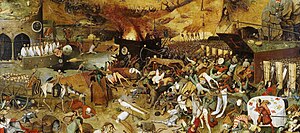The Triumph of Death (Pieter Bruegel the Elder)

|
| The triumph of death |
|---|
| Pieter Bruegel the Elder , around 1562 |
| oil on wood |
| 117 × 162 cm |
| Museo del Prado , Madrid |
The Triumph of Death is a painting by the Flemish painter Pieter Bruegel the Elder . It was created around 1562 in oil on wood and is now exhibited in the Museo del Prado in Madrid.
description
Bruegel's 117 centimeter high and 162 centimeter wide representation is embedded in a landscape panorama. Here the artist shows in great detail the scenario in which death triumphs over earthly things: the sky is colored black by the smoke of burning cities. Part of the sea can be seen in the background; there is no more suitable ship floating there, only half-sunken wrecks. Corpses are strewn everywhere. The few who are still alive are approached by an army of skeletons, overwhelming because of their sheer number. The living flee or try to defend themselves. In a multitude of different individual scenes different ways are shown how the skeletons kill their victims, for example by beheading, hanging, wheeling , drowning or by setting animals on them. A skeleton rides a reddish horse over a crowd and wields a scythe, others use spears or axes to kill. A crowd is driven into a trap decorated with crosses that looks like a huge coffin.
- Cutouts
interpretation
The triumph of death has been a theme in European cultural history since the Middle Ages, especially in the fine arts. This theme is spread over the entire surface of the picture in numerous isolated individual scenes: from the desolate, slightly mountainous foreground to the sea in the background, people fight against the overwhelming death, or are fetched by it, only the rolling hell furnace filled with flames with portholes and mouth hole in the center of the picture is not occupied by skeletons but by devil figures. This infernal furnace and the grim reaper hurrying ahead of it are an allusion to the Revelation of John , in which the underworld follows the riding death.
The large figures at the lower edge of the picture are representatives of the estates society : In the lower left corner lies a fully armed king with an ermine and scepter. A skeleton holds up an hourglass to him: life and reign have expired. Meanwhile, a second skeleton is rummaging through money and gold, another in a cardinal's hat supports a sinking cardinal to alleviate his fall. A dead mother lies diagonally behind it: a starved dog is sniffing the child. A kneeling skeleton cuts the throat of a pilgrim who is stripped to his shirt and who has come to the end of his life's journey: even a pious lifestyle does not protect against such an end. Several scenes are arranged around the set table on the right edge of the picture: a fool crawls over the board and cards under the table, a skeleton dressed in a human mask pours out wine, a nobleman draws his sword and a skeleton in a cowl with donkey ears serves two women with a skull with thigh bone. The lovers playing music in the lower right corner, on the other hand, are completely related to themselves and are not bothered by the hustle and bustle, not even by the boneless man who is already accompanying them.
Provenance
The painting belonged to Queen Elisabetta Farnese of Spain and was in the royal palace of La Granja in 1745 . From there it was transferred to the Museo del Prado in Madrid in 1827 .
Copies
A copy of Jan Brueghel the Elder, dated 1597, in oil on canvas is in the Alte Galerie Schloss Eggenberg , Graz (Inv.-No .: 58), as well as another in the collection of the Princes of Liechtenstein. Another version of the picture was painted by Pieter Brueghel the Younger around 1608, which is in the holdings of the Kunstmuseum Basel .
Jan Brueghel the Elder from 1597, in Eggenberg Palace
See also
Web links
- The triumph of death in the Prado's online gallery (English / Spanish)
literature
- Anna Pawlak: Trilogy of the Search for God. Pieter Bruegel the Elder Ä. Fall of the Fallen Angels, Triumph of Death and Dulle Griet , Berlin 2011, pp. 87–142.
- Richard B. Woodward: Death Takes No Holiday . In: The Wall Street Journal . February 14, 2009 ( article online [accessed January 23, 2012]).
Individual evidence
- ↑ a b c On-line gallery: The Triumph of Death. Museo del Prado , accessed September 1, 2011 .
- ↑ a b The triumph of death from the series 1000 masterpieces . Commentary by Karlheinz Nowald , read by Rudolf Jürgen Bartsch . RM Arts in coproduction with WDR
- ↑ Ars - visual acuity - Affectus: Visual Cultures of affective in the early modern period . Edited by Anna Pawlak, Lars Zieke, Isabella Augart. Walter de Gruyter 2016 p. 166
- ↑ Alte Galerie Schloss Eggenberg: Triumph of Death - Jan Brueghel d. Ä. Universalmuseum Joanneum 2018, accessed on June 4, 2019
- ↑ Triumph of Death, 1608 (?) Inv. G 1995.29. In: Collection Online. Kunstmuseum Basel, accessed on September 9, 2019 .







